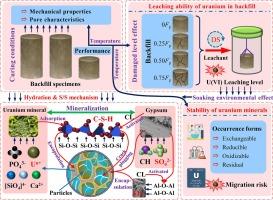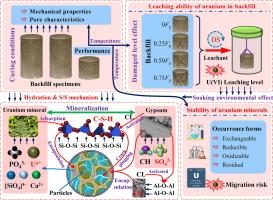温度和破坏程度对铀尾矿充填材料铀浸出水平的影响及其S/S机制
IF 9
1区 工程技术
Q1 ENGINEERING, CHEMICAL
引用次数: 0
摘要
堆浸铀尾矿排放造成的环境污染是各产铀国家面临的一个重大问题。提出了以少量熟料(CL)和磷渣(PS)为粘结剂与HLUTs混合的新型充填材料配方,以达到处理危险废物和管理采空区的双重目的。研究了不同条件下充填材料的力学性能、孔隙特征、U的赋存形态以及U(VI)的浸出行为,并阐明了U(VI)和SO42-的S/S机制。结果表明,将固化温度从20 °C提高到30 °C,可以使强度快速发展从7 ~ 90 d提前到0 ~ 28 d,孔隙率降低;U的赋存形态受养护温度和浸泡环境的影响较小。在弱酸环境下,受损回填体中U(VI)的浸出水平低于规定限值。此外,CL中的Ca(OH)2、CL中的C3A、PS中的正磷酸盐等组分分别促进体系中石膏、钙矾石(AFt)和新生U矿物等相的形成,后者被水合硅酸钙(C-S-H)凝胶吸附并包封,实现了U(VI)和SO42-的固化/稳定化(S/S)。研究结果为可持续地管理hlut和其他固体废物提供了强有力的理论框架和令人信服的经验证据,目标是实现最低排放。本文章由计算机程序翻译,如有差异,请以英文原文为准。


Effects of temperature and damage degree on the uranium leaching levels of uranium tailings filling materials and their S/S mechanism
Environmental pollution aroused by the discharge of heap leaching uranium tailings (HLUTs) is a significant issue in uranium-producing countries. This study presented a new formulation for filling material that utilized few clinker (CL) and phosphorus slag (PS) as binders blended with HLUTs to achieve dual goals of dealing with hazardous waste and managing mined-out areas. The mechanical properties, pore characteristics, U occurrence forms, and U(VI) leaching behavior of filling materials under various conditions were all investigated, and the S/S mechanism for U(VI) and SO42- were also elucidated. The results showed that elevating the curing temperature from 20 °C to 30 °C resulted in an advancement of rapid strength development from 7–90 d to 0–28 d and a reduction in porosity. The U occurrence forms were less affected by curing temperature and soaking environment. In weak acid environments, the leaching levels of U(VI) in damaged backfill were lower than prescribed limits. Moreover, components such as Ca(OH)2, C3A in CL, and orthophosphate in PS could promote the formation of gypsum, ettringite (AFt), and newborn U minerals and other phases in the system, respectively, the latter were adsorped and encapsulated by calcium silicate hydrate (C-S-H) gels, achieving solidification/stabilization (S/S) for U(VI) and SO42-. The findings present a robust theoretical framework and compelling empirical evidence for the sustainable management of HLUTs and other solid waste, with the goal of achieving minimal emissions.
求助全文
通过发布文献求助,成功后即可免费获取论文全文。
去求助
来源期刊

Separation and Purification Technology
工程技术-工程:化工
CiteScore
14.00
自引率
12.80%
发文量
2347
审稿时长
43 days
期刊介绍:
Separation and Purification Technology is a premier journal committed to sharing innovative methods for separation and purification in chemical and environmental engineering, encompassing both homogeneous solutions and heterogeneous mixtures. Our scope includes the separation and/or purification of liquids, vapors, and gases, as well as carbon capture and separation techniques. However, it's important to note that methods solely intended for analytical purposes are not within the scope of the journal. Additionally, disciplines such as soil science, polymer science, and metallurgy fall outside the purview of Separation and Purification Technology. Join us in advancing the field of separation and purification methods for sustainable solutions in chemical and environmental engineering.
 求助内容:
求助内容: 应助结果提醒方式:
应助结果提醒方式:


